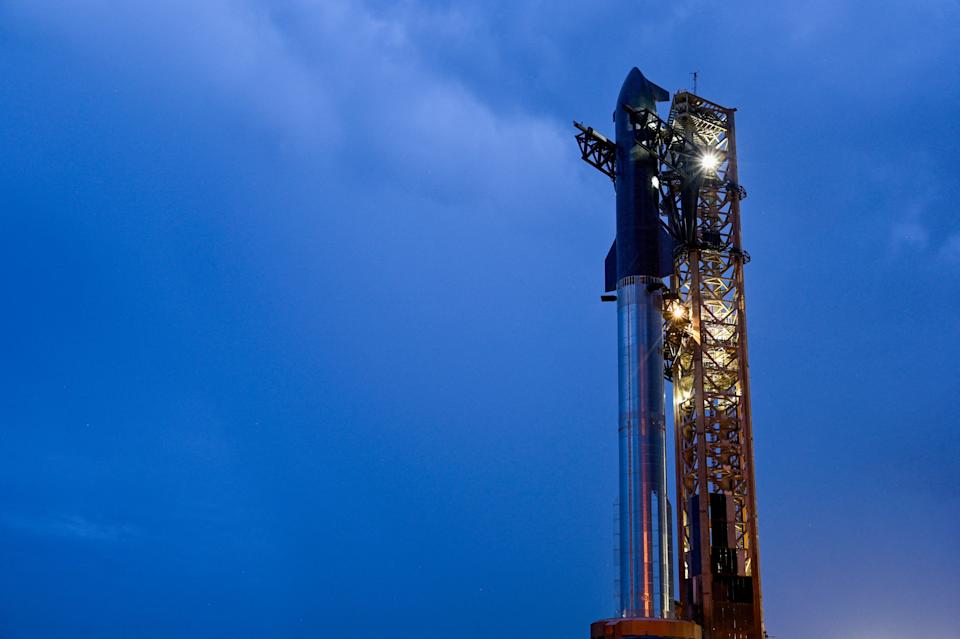SpaceX didn't end up launching its gigantic Starship spacecraft on schedule, but Elon Musk's rocket company isn't waiting long to try again.
The 400-foot Starship rocket, which SpaceX is developing for crewed travel to Mars, was vertical on the launch pad and being fueled up for an imminent takeoff from South Texas before the commercial spaceflight company opted to scrub the launch. In a post on social media site X, which Musk owns, SpaceX attributed the decision to "an issue with ground systems."
Fortunately for the billionaire tech mogul, whose company has faced a series of explosive setbacks in Starship's development in 2025, the delay doesn't appear to be lasting long. SpaceX will soon attempt to launch the vehicle for the 10th time in more than two years on an uncrewed test mission it simply refers to as flight 10.
Here's everything to know about the Starship scrub, and when SpaceX could attempt to launch the spacecraft again.
What happened with the Starship launch? SpaceX postpones test in Texas
Starship was scheduled to get off the ground at 6:30 p.m. CT on Aug. 24 at SpaceX's Starbase headquarters near the U.S.-Mexico border, which Texas voters in Cameron County approved in May to become a city.
Everything appeared to be on track for Starship to launch on time as SpaceX began fueling up the massive spacecraft before the company announced that it had called off the mission nearly 15 minutes before liftoff.
SpaceX had a number of objectives for flight 10.
During three separate Starship launches since October, SpaceX has proven it's capable of returning and "catching" the massive spacecraft's rocket booster at the so-called "mechazilla" tower at the launch pad using a pair of mechanical arms nicknamed "chopsticks."
This time around, the rocket company planned to turn its attention elsewhere: safely returning and landing the vehicle's upper stage — known as Starship, or Ship — where a crew of astronauts would one day ride to space.
SpaceX also had plans to deploy eight test Starlink satellites expected to burn up in Earth's atmosphere upon re-entry — an objective called off on three previous launches. SpaceX additionally planned to reignite its Raptor engines in space to attempt an orbital burn, a crucial maneuver to ground a vehicle.
For the second time in a row, SpaceX had no plans to recover the booster, known as Super Heavy. Instead, the company has again sought to push Super Heavy's performance beyond what has been attempted.
The booster was intended to attempt several in-flight experiments before making a water landing off the Gulf of Mexico, renamed by the U.S. government as the Gulf of America.
When could SpaceX launch Starship on flight 10?

SpaceX's website indicates the company is working toward a Starship launch as early as 6:30 p.m. CT Monday, Aug. 25.
A Federal Aviation Administration operations plan advisory confirms that launch windown and also indicates that backup opportunities remain available the next day if the mission is scrubbed again.
Scheduled test comes after high-profile Starship explosions
The flight test was previously delayed on June 18 when the Starship vehicle SpaceX assigned to the next flight, designated Ship 36, unexpectedly exploded while SpaceX was preparing it for launch. No one was hurt in the incident, which occurred as the Starship spacecraft was standing alone on the test stand being filled with cryogenic propellants for an engine test-firing before being mounted on top of the rocket booster.
The mishap, which SpaceX later referred to on its website as "a sudden energetic event," destroyed the spacecraft and ignited several fires that caused damage in the area surrounding the test stand.
The explosion was the latest fiery mishap SpaceX's Starship has encountered during – and, now, before – its flight tests in 2025.
Starship's most recent demonstration came on May 27, when the spacecraft spun out of control roughly halfway through its flight and disintegrated in a fireball. Though Starship was unable to achieve its most important objectives, the distance the vehicle traveled far surpassed the previous 2025 flights in January and March, when Starship exploded within minutes.
But Starship, which has yet to reach orbit in any of its flight tests since the first in April 2023, has failed to replicate the successes of previous flights in 2024.
What is Starship? SpaceX develops rocket for missions to moon, Mars
SpaceX has become known for its risk-tolerant philosophy when it comes to Starship's development. Musk has stressed that rapid and frequent testing, which sometimes leads to explosive ends, can still provide data that helps engineers improve the vehicle's design.
SpaceX is developing Starship to be a fully reusable transportation system, meaning the rocket and vehicle can return to the ground for additional missions.
In the years ahead, Starship is set to serve a pivotal role in future U.S. spaceflight. Starship is the centerpiece of Musk's vision of sending the first humans to Mars, and is also critical in NASA's plans to return astronauts to the moon's surface.
Musk aims to send the first uncrewed Starship to Mars in 2026. NASA, meanwhile, has designs on using Starship to ferry Artemis III astronauts from orbit to the lunar surface as early as 2027.
Trump, FAA hand SpaceX big wins
As Musk seeks to ramp up development of the Mars-bound spacecraft, the U.S government has handed SpaceX a few key wins in 2025.
Most recently, President Donald Trump signed earlier in August an executive order aimed at rolling back federal regulations on commercial spaceflight companies – a sign that private sector rocket companies like SpaceX remain crucial to U.S. spaceflight ambitions, even after a public falling out between Trump and Musk.
The move came a few months after the Federal Aviation Administration, which licenses commercial rocket launches, gave approval in May for SpaceX to conduct as many as 25 Starship test flights a year. Starship launched just four times in 2024.
How big is Starship?
The Starship, standing 403 feet tall when fully stacked, is regarded as the world's largest and most powerful launch vehicle ever developed. When fully integrated, the launch system is composed of both a 232-foot Super Heavy rocket and the 171-foot upper stage Starship itself, the spacecraft where crew and cargo would ride.
Super Heavy alone is powered by 33 of SpaceX’s Raptor engines that give the initial burst of thrust at liftoff. The upper stage Starship section is powered by six Raptor engines that will ultimately travel in orbit.
Eric Lagatta is the Space Connect reporter for the USA TODAY Network. Reach him at [email protected]
This article originally appeared on Corpus Christi Caller Times: We have new date for next Starship rocket launch after SpaceX scrub







Comments